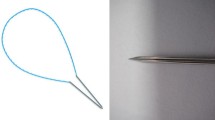Abstract
Background
Many recent advances in face lift techniques have been made to reverse the aging process of the mid-face. In this study, we present a new technique by which mid-face rejuvenation can be achieved in double-angle vectors and allows adaption to the underlying bony structure. The locked cheek lift (LCL) allows effective, simple and rapid lifting of the malar fat pad in two planes. Correction of the curvature of the face and reduction of the height of lid cheek junction distance can be achieved without an incision at the lower eyelid.
Methods
In total, 115 patients (77 females and 38 males) have been operated on using the LCL technique by a single surgeon; patient ages ranged between 37 and 71 years old (average = 51). Follow-up was performed by the same team for a year postoperatively. The facial expression and lid cheek distance have been evaluated during this period.
Results
After a year from the operation, the lid cheek distance correction was maintained in 95.7% of the cases, with stable position of the ascended malar fat pad. Postoperative edema and ecchymosis were limited.
Conclusion
LCL is an effective, simple and rapid surgical technique, which is capable of correcting the cheek gravitational migration, reducing the lid cheek distance (LCD), maintaining the ascended stable malar fat pad for a long time with a short recovery period and minimal risk of complications.
Level of Evidence IV
This journal requires that authors assign a level of evidence to each article. For a full description of these Evidence-Based Medicine ratings, please refer to the Table of Contents or the online Instructions to Authors www.springer.com/00266.










Similar content being viewed by others
References
Rohrich R (2007) Compartments of the face: anatomy and clinical implications for cosmetic surgery. Plast Reconstr Surg 119:2219–2227
Rohrich R, Pessa J, Ristow B (2008) The youthful cheek and the deep medial fat compartment. Plast Reconstr Surg 121:2107–2112
Owsley JQ, Roberts CL (2008) Some anatomical observations on midface aging and long-term results of surgical treatment. Plast Reconstr Surg 121:258–268
Lambros V (2007) Observations on periorbital and midface aging. Plast Reconstr Surg 120:1367–1376
Gierloff M, Stohring C, Buder T, Gassling V, Açil Y, Wiltfang J (2012) Aging changes of the mid facial fat compartments: a computed tomographic study. Plast Reconstr Surg 129:26373
Pessa J, Vikram P (1998) Relative maxillary retrusion as a natural consequence of aging combining skeletal and soft-tissue changes into an integrated model of midfacial aging. Plast Reconstr Surg 102(1):205–212
Lelouarn C (2007) The face recurve concept: medical and surgical applications. Aesthet Plast Surg 31:219–231
Besins T (2004) The, “R.A.R.E.” technique: the renaissance of the aging face and neck. Aesthet Plast Surg 28:127–142
Owsley JQ, Zweifler M (2002) Midface lift of the malar fat pad: technical advances. Plast Reconstr Surg 110:674–685
Paul M, Calvert J (2006) The evolution of midface lift in aesthetic plastic surgery. Plast Reconstr Surg 117:1809–1827
Patrocinio LG et al (2013) Subperiosteal midface lift. Facial Plast Surg 29:206–213
Raminrez OM (1998) High tech facelift. Aesthet Plast Surg 22:318–328
Hachach-Haram N (2013) Midface-lifting: evolution, indications and technique. Facial Plast Surg 29:289–294
De La Plaza R et al (1991) Supraperiosteal lifting of the upper two thirds of the face. Br Plast Surg 44:325–332
Divaris M, Blugerman G, Paul M (2014) Face expressive lifting (FEL): un original surgical concept combined with bipolar radiofrequency. Eur J Plast Surg 37:69–76
Acknowledgements
None of the authors has financial interest in any of the products, devices or drugs mentioned in the manuscript.
Author information
Authors and Affiliations
Corresponding author
Electronic supplementary material
Below is the link to the electronic supplementary material.
Subperiosteal dissection (MP4 47868 kb)
Passing of the thread through the tunnel (MP4 36934 kb)
LCD reduction with vertical vector lifting of midface (MP4 19355 kb)
Release of the indentations (MP4 68386 kb)
Rights and permissions
About this article
Cite this article
Divaris, M., Sabri, E., Cancemi, G. et al. LCL: (Locked Cheek Lift) Three-Dimensional Cheek Lift and Inferior Palpebral Rejuvenation. Aesth Plast Surg 42, 825–838 (2018). https://doi.org/10.1007/s00266-018-1086-1
Received:
Accepted:
Published:
Issue Date:
DOI: https://doi.org/10.1007/s00266-018-1086-1




